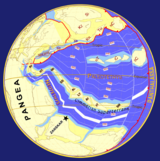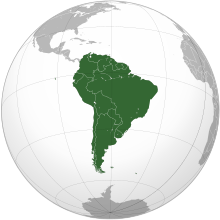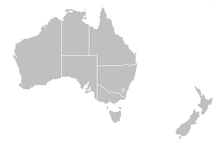Chronology of continents
A continent is a large geographical region defined by the continental shelves and the cultures on the continent. In the modern day, there are seven continents. However, there have been more continents throughout history. Vaalbara was the first supercontinent. Europe is the newest continent. Geologists have predicted that certain continents will appear, these being Pangaea Proxima, Novopangaea, Aurica, and Amasia.
List of Continents
| Name | Era | Time before present | Image | Reference |
|---|---|---|---|---|
| Vaalbara | Eoarchean | 3.6-2.7 Ga | 
|
|
| Ur | Paleoarchean | 3.1 Ga | 
|
|
| Kenorland | Neoarchean | 2.7 Ga | 
|
|
| Arctica | Neoarchean | 2.565 Ga | 
|
|
| Columbia | Paleoproterozoic | 2.1-1.5 Ga | 
|
|
| Atlantica | Paleoproterozoic | 2.0 Ga | 
|
|
| Nena | Paleoproterozoic | 1.9 Ga | ||
| Baltica | Paleoproterozoic | 1.8 Ga | 
|
|
| Rodinia | Neoproterozoic | 1100-633 Ma | ||
| Avalonia | Neoproterozoic | 750 Ma | 
|
|
| Pannotia | Neoproterozoic | 500-600 Ma | 
|
|
| Pampia | Neoproterozoic | 555-515 Ma | ||
| Gondwana | Neoproterozoic | 550 Ma | 
|
|
| Cimmeria | Neoproterozoic | 550 Ma | 
|
|
| Laurasia | Neoproterozoic | 550 Ma | 
|
|
| Cuyania | Paleozoic | ~420-390 Ma | ||
| Chilenia | Paleozoic | ~420-390 Ma | ||
| Pangaea | Paleozoic | 335 Ma | 
|
|
| Africa | Paleozoic | 300 Ma | 
|
|
| South America | Mesozoic | 225 Ma | 
|
|
| North America | Mesozoic | 200 Ma | 
|
|
| Mauritia | Mesozoic | 70-60 Ma | 
|
|
| Asia | Mesozoic | 66 Ma | 
|
|
| Australia | Cenozoic | 10 Ma | 
|
|
| Europe | Cenozoic | 5 Ma | 
|
|
| Pangaea Proxima | ~250 myf | 
|
||
| Novopangaea | ~250 myf | 
|
||
| Aurica | ~250 myf | |||
| Amasia | ~250 myf | 
|
References
- ^ "Continent". National Geographic Society. 2011-09-20. Archived from the original on 2021-03-03. Retrieved 2021-02-01.
- ^ a b Zegers, T. E.; de Wit, M. J.; White, S. H. (1998). "Vaalbara, Earth's oldest assembled continent? A combined. structural, geochronological, and palaeomagnetic test" (PDF). Terra Nova. 10(5): 250–259.
- ^ a b Willams, Caroline; Nield, Ted (2007). "Earth's next supercontinent". New Scientist. 196 (2626): 36–40. doi:10.1016/S0262-4079(07)62661-X.
- ^ Rogers & Santosh 2003, Rodinia, pp. 363–364
- ^ Pesonen, L. J.; Elming, S.-Å.; Mertanen, S.; Pisarevsky, S.; D’Agrella-Filho, M. S.; Meert, J. G.; Schmidt, P. W.; Abrahamsen, N.; Bylund, G. (2003). "Palaeomagnetic configuration of continents during the Proterozoic". Tectonophysics. 375 (1–4): 289–324
- ^ Vernikovsky, V. A.; Dobretsov, N. L. (2015). "Geodynamic evolution of the Arctic Ocean and modern problems in geological studies of the Arctic region". Herald of the Russian Academy of Sciences. 85 (3): 206–212.
- ^ Zhao, G.; Cawood, P. A.; Wilde, S. A.; Sun, M. (2002). "Review of global 2.1–1.8 Ga orogens: implications for a pre-Rodinia supercontinent". Earth-Science Reviews. 59 (1): 125–162.
- ^ Rogers, John J. W. (1996). "A History of Continents in the past Three Billion Years". The Journal of Geology. 104 (1): 91–107. Bibcode:1996JG....104...91R. doi:10.1086/629803. ISSN 0022-1376. S2CID 128776432. Archived from the original on 2021-03-03. Retrieved 2021-02-01.
- ^ Gower, Ryan & Rivers 1990, Introduction, p. 2
- ^ Cocks, L. R. M.; Torsvik, T. H. (2005). "Baltica from the late Precambrian to mid-Palaeozoic times: the gain and loss of a terrane's identity" (PDF). Earth-Science Reviews. 72 (1–2): 39–66.
- ^ a b Gaucher, Claudio; Bossi, Jorge; Blanco, Gonzalo (2009). "Palaeogeography". Neoproterozoic-Cambrian Tectonics, Global Change and Evolution: A Focus on South Western Gondwana. Developments in Precambrian Geology. 16. pp. 131–41. doi:10.1016/S0166-2635(09)01609-0. ISBN 978-0-444-53249-7.
- ^ Murphy, J. B.; Pisarevsky, S. A.; Nance, R. D.; Keppie, J. D. (2001). Jessell, M. J. (ed.). "Animated history of Avalonia in Neoproterozoic - Early Proterozoic". General Contributions. Journal of the Virtual Explorer. 3: 45–58. doi:10.3809/jvirtex.2001.00026. Retrieved 28 November 2015.
- ^ Scotese 2009, Reconstruction of Rodinia and Pannotia, p. 68
- ^ Bradley, D.C. (2011). "Secular Trends in the Geologic Record and the Supercontinent Cycle". Earth-Science Reviews. 108 (1–2): 16–33. CiteSeerX 10.1.1.715.6618. doi:10.1016/j.earscirev.2011.05.003.
- ^ Buchs, D. M.; Bagheri, S.; Martin, L.; Hermann, J.; Arculus, R. (2013). "Paleozoic to Triassic ocean opening and closure preserved in Central Iran: Constraints from the geochemistry of meta-igneous rocks of the Anarak area". Lithos. 172: 267–287.
- ^ a b Blakey 2003, Assembly of Western Pangaea: Carboniferous–Permian, pp. 453–454; Assembly of Eastern Pangaea: Late Permian–Jurassic, p. 454; Fig. 10, p. 454
- ^ Rapalini 2005
- ^ Rapalini, A.E. 2005. The accretionary history of southern South America from the latest Proterozoic to the Late Palaeozoic: some palaeomagnetic constraints. From: Vaughan, A. R M., Leat, P. T. & Pankhurst, R. J, (eds). Terrane Processes at the Margins of Gondwana. Geological Society, London, Special Publications, 246, 305-328.
- ^ "Africa - Geologic history". Encyclopedia Britannica. Archived from the original on 2021-01-25. Retrieved 2021-02-01.
- ^ "South America - Geologic history". Encyclopedia Britannica. Archived from the original on 2020-05-07. Retrieved 2021-02-04.
- ^ "North America - Tectonic evolution". Encyclopedia Britannica. Archived from the original on 2015-05-03. Retrieved 2021-02-01.
- ^ Torsvik, Trond H.; Amundsen, Hans; Hartz, Ebbe H.; Corfu, Fernando; Kusznir, Nick; Gaina, Carmen; Doubrovine, Pavel V.; Steinberger, Bernhard; Ashwal, Lewis D.; Jamtveit, Bjørn (24 February 2013). "A Precambrian microcontinent in the Indian Ocean" (PDF). Nature Geoscience. 6 (3): 223–227. doi:10.1038/ngeo1736. hdl:10852/62002. ISSN 1752-0894. Retrieved 5 December 2015.
- ^ "Asia - Geologic history". Encyclopedia Britannica. Archived from the original on 2008-11-18. Retrieved 2021-02-01.
- ^ "Australia - Geologic history". Encyclopedia Britannica. Archived from the original on 2015-05-02. Retrieved 2021-02-01.
- ^ "Europe - Geologic history". Encyclopedia Britannica. Archived from the original on 2014-12-12. Retrieved 2021-02-01.
- ^ a b c Wilkins, Alasdair. "A Geological History of Supercontinents on Planet Earth" at io9. 27 Jan 2011. Accessed 22 July 2014.